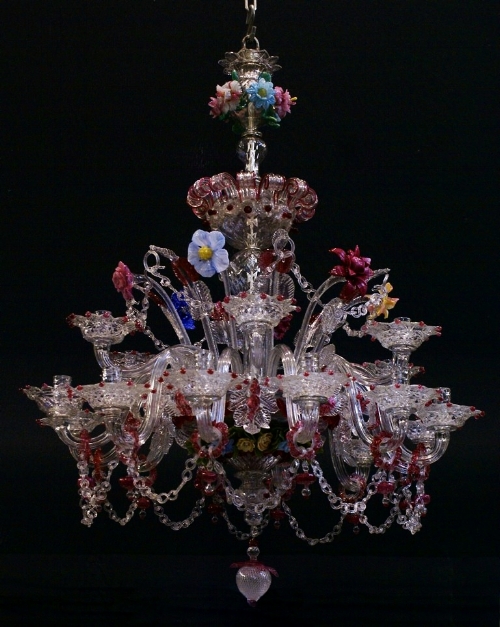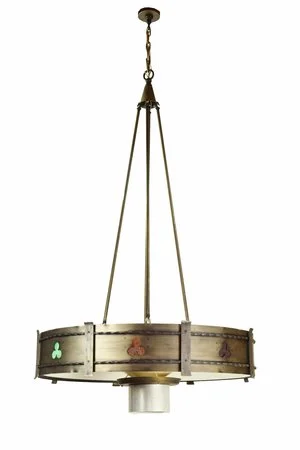A Portrait of the Salesman as a Young Man
/A journey through U.S. Census records, birth and death certificates, and antique poultry magazines in search of "J.B.Fithian, Factory Representative."
Read MoreA journey through U.S. Census records, birth and death certificates, and antique poultry magazines in search of "J.B.Fithian, Factory Representative."
Read MoreWhen you think of crystal chandeliers, your mind probably goes straight to large, elaborate structures, a la Versailles or Beauty and the Beast:


In reality, the first uses of crystal in lighting appeared long before Marie Antoinette ate her cake and Belle waltzed to the sound of Angela Lansbury's voice. Crystal chandeliers appeared in the late 16th century and were designed with natural rock crystals, making them difficult to produce and expensive to own. Roughly a century later, in 1676, Englishman George Ravenscroft patented flint glass, a new material made with significant amounts of lead oxide that made it easier to cut and more prismatic. This marked the advent of English style chandeliers, identified by metal pieces in the main shaft, receiver bowl, and receiver plate, and glass arms extending from the plate to the drip pans. Unfortunately, few chandeliers from this time survive today, but the shape is quite familiar!
At the same time, Venetian glass makers were continuing to develop a glass-manufacturing industry that dates back to the 8th century and the Roman Empire. The Glassmakers Guild moved all furnaces to the island of Murano in the 13th century, for the dual purpose of preventing fires from spreading to the wooden structures of the city and making it harder for the artisans to reveal trade secrets. To add their own touch to the growing popularity of glass chandeliers, Murano glassmakers began to add molded glass flowers and leaves to chandeliers that could extend up to eight feet wide!

While not eight feet wide, this Venetian chandelier at Dumfries House in Ayrshire, Scotland is an excellent example of the colored glass that became popular in the late 17th-early 18th centuries.
The 17th century also ushered in the opulent style often associated with Versailles--French Baroque or le style Louis Quatorze. With an open birdcage frame of gilded bronze in a vase or lyre shape and decorations of shining cut rock crystals, this style was highly sought after among the royalty of Europe, from Charles II of England to Maria Theresa of Austria.
The next two major developments in the glass chandelier industry came as a response to England's Glass Excise Act, which taxed glass by weight. Ireland was exempt from the tax, so many manufacturers moved their operations to locations like Waterford, which led to the growth of the world-renowned Waterford Glass House. Those who stayed in England resorted to cutting crystal drops from pieces of broken glass, which was taxed more cheaply, and strung them together like a tent, with a "bag" of more drops at the bottom--creating the tent-and-bag style:
The Glass Excise Act ended in 1835, around the time that the Industrial Revolution was transforming chandelier production. Mechanization allowed for faster and cheaper manufacturing, and a growing middle class meant there was a larger audience eager to show off their rising socioeconomic status. In particular, Daniel Swarovski's crystal cutting machine made it much more affordable to own diamond-like crystals, and launched an enterprise that is still around to this day!
Today, we can see that many of these old styles are still quite popular, such as Dutch brass-ball stem, French Baroque, and Georgian. Here at Architectural Antiques, we have a large collection of chandeliers that compliment a wide range of styles. Whether you're looking for Art Deco or Art Nouveau...
Colonial or Mid-Century Gothic...

Mid-Century Gothic chandelier available in store!
...we've got the chandelier for you! In store or online, please Be Our Guest!

Remember: the best way to find the proper hanging height for your light is to test it out and try different options to see what works best for your individual, unique situation!
antique & vintage lighting, stained, leaded & prairie glass windows
wood mantles, stone mantles, doors, entryways, original hardware
hand wrought iron work, terra-cotta, carved stone, antique garden elements
vintage plumbing, antique religious elements, ecclesiastical artifacts
plus an ever changing inventory of just cool & funky decorative items!
building deconstruction, salvage and re-purposing of antique architectural elements.